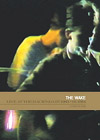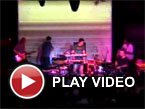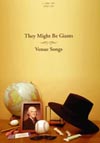 They Might Be Giants wrote and recorded a brand new song for each stop on their 2004 tour and this DVD/CD combo documents the results. After nearly two decades of TMBG records, videos, tours, antics and other work, Venue Songs is exactly what any fan of the band might expect: a collection of often funny and clever tunes and images.
They Might Be Giants wrote and recorded a brand new song for each stop on their 2004 tour and this DVD/CD combo documents the results. After nearly two decades of TMBG records, videos, tours, antics and other work, Venue Songs is exactly what any fan of the band might expect: a collection of often funny and clever tunes and images. They Might Be Giants wrote and recorded a brand new song for each stop on their 2004 tour and this DVD/CD combo documents the results. After nearly two decades of TMBG records, videos, tours, antics and other work, Venue Songs is exactly what any fan of the band might expect: a collection of often funny and clever tunes and images.
They Might Be Giants wrote and recorded a brand new song for each stop on their 2004 tour and this DVD/CD combo documents the results. After nearly two decades of TMBG records, videos, tours, antics and other work, Venue Songs is exactly what any fan of the band might expect: a collection of often funny and clever tunes and images.
15683 Hits
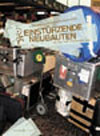 Here is another DVD release which would make any die hard fan excited. Einstürzende Neubauten have always been a group which has had an intimate relationship with their fans and supporters and this documentary is a great snapshot of the experience with the group's Internet inetractivity and tour following their Perpetuum Mobile release.
Here is another DVD release which would make any die hard fan excited. Einstürzende Neubauten have always been a group which has had an intimate relationship with their fans and supporters and this documentary is a great snapshot of the experience with the group's Internet inetractivity and tour following their Perpetuum Mobile release.
15836 Hits
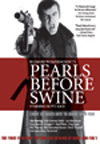 Finally available to the general public on DVD, this movie is the quintessential film for any hardcore Boyd Rice/Non and Death In June fan. However, it's hardly any wonder this film only did the festival circuit and never went out to a widescale release.
Finally available to the general public on DVD, this movie is the quintessential film for any hardcore Boyd Rice/Non and Death In June fan. However, it's hardly any wonder this film only did the festival circuit and never went out to a widescale release.
17307 Hits
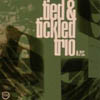 Of all the bands that Marcus and Mica Acher are in, the Tied & Tickled Trio are probably the ensemble with the comparitively most releases who do the least amount of globetrotting. The primary purpose of this release is the hour-long live concert for Observing Systems, filmed in April of 2004, but the bonus material of music videos, live TV appearances, and a CD of unreleased material makes for a fantastic package that will please nearly every fan.
Of all the bands that Marcus and Mica Acher are in, the Tied & Tickled Trio are probably the ensemble with the comparitively most releases who do the least amount of globetrotting. The primary purpose of this release is the hour-long live concert for Observing Systems, filmed in April of 2004, but the bonus material of music videos, live TV appearances, and a CD of unreleased material makes for a fantastic package that will please nearly every fan.
15005 Hits
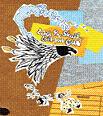 If reckless enthusiasm and unabashed idealism in DIY ethics were a
college course, than the Mae-Shi would be its happy-go-lucky T.A. to
Fugazi’s stern, taskmaster professor. In a little over three years, the
L.A. quintet have put others to shame with their breathless recording
and touring schedule. And while it seems the band is laying low
following a second national tour and the release of the Heartbeeps EP
this past summer, the band has done their fan base a favor by releasing
another chunk of their spazzy, synapse addled spazz-pop, this time in
the form of a full DVD.
If reckless enthusiasm and unabashed idealism in DIY ethics were a
college course, than the Mae-Shi would be its happy-go-lucky T.A. to
Fugazi’s stern, taskmaster professor. In a little over three years, the
L.A. quintet have put others to shame with their breathless recording
and touring schedule. And while it seems the band is laying low
following a second national tour and the release of the Heartbeeps EP
this past summer, the band has done their fan base a favor by releasing
another chunk of their spazzy, synapse addled spazz-pop, this time in
the form of a full DVD.
12651 Hits
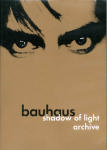 Finally on DVD, this features Bauhaus' two most complete video compilations that
were circulating around since the 1980s. I always thought each of these
video programs were named what the other should be, as Shadow of Light
is a collection of nine promotional music video shorts, some taken from
live performances and some with decent sized budgets, while Archive
is a 10-song performance film with live shots interspresed with footage
of non-band members running around some old English town.
Finally on DVD, this features Bauhaus' two most complete video compilations that
were circulating around since the 1980s. I always thought each of these
video programs were named what the other should be, as Shadow of Light
is a collection of nine promotional music video shorts, some taken from
live performances and some with decent sized budgets, while Archive
is a 10-song performance film with live shots interspresed with footage
of non-band members running around some old English town.
13144 Hits
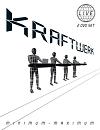 Minimum-Maximum is a fine overview of Kraftwerk’s career. When I first heard the CD version
I was glad to hear again what I had experienced live but only with this DVD do I feel that the
Kraftwerk live experience has been reproduced in the quality that it is worthy of.
Minimum-Maximum is a fine overview of Kraftwerk’s career. When I first heard the CD version
I was glad to hear again what I had experienced live but only with this DVD do I feel that the
Kraftwerk live experience has been reproduced in the quality that it is worthy of.
14000 Hits
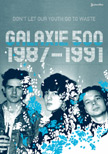 The title is a little strange largely for the fact that it is a
Jonathan Richman song which Galaxie 500 covered but did not pen
themselves. I would even be hesitant to say that they popularized the
tune, but perhaps the title was just too perfect for Plexifilm to
ignore (messy details of authorship be damned). Nonetheless, it makes
me want to collect a bunch of White Lion bootlegs and make a DVD
entitled Radar Love, or maybe a bunch of Great White TV appearances and
call it Once Bitten, Twice Shy.
The title is a little strange largely for the fact that it is a
Jonathan Richman song which Galaxie 500 covered but did not pen
themselves. I would even be hesitant to say that they popularized the
tune, but perhaps the title was just too perfect for Plexifilm to
ignore (messy details of authorship be damned). Nonetheless, it makes
me want to collect a bunch of White Lion bootlegs and make a DVD
entitled Radar Love, or maybe a bunch of Great White TV appearances and
call it Once Bitten, Twice Shy.
13934 Hits
 This video documentary, produced and originally released in 1993, has a ton of great footage and interviews from all members of the band from their inception through 1993's Tabula Rasa.
This video documentary, produced and originally released in 1993, has a ton of great footage and interviews from all members of the band from their inception through 1993's Tabula Rasa.
13906 Hits
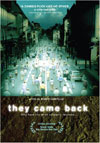 This bloodless zombie movie from France winds up saying more
about the human condition than anyone might have expected of a film
full of the walking dead. By throwing out genre conventions and
focusing on the human story, this quiet character film turns out to be
creepier and more anxiety-inducing than almost any film with a proper
gut-chewing scene.
This bloodless zombie movie from France winds up saying more
about the human condition than anyone might have expected of a film
full of the walking dead. By throwing out genre conventions and
focusing on the human story, this quiet character film turns out to be
creepier and more anxiety-inducing than almost any film with a proper
gut-chewing scene.
13048 Hits
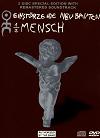 Sohgo Ishii’s movie of Einstürzende Neubauten’s first visit to Japan is a mesmerising
piece of work. Ishii mainly filmed Neubauten both at a traditional concert and at a private
performance in a disused factory. The industrial setting suits the band perfectly and vice versa. This
movie documents the old lineup in its prime.
Sohgo Ishii’s movie of Einstürzende Neubauten’s first visit to Japan is a mesmerising
piece of work. Ishii mainly filmed Neubauten both at a traditional concert and at a private
performance in a disused factory. The industrial setting suits the band perfectly and vice versa. This
movie documents the old lineup in its prime.
16538 Hits
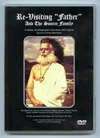 The storied and obscure LPs recorded by the cult of Ya Ho Wha
throughout the 1970s are as legendary as it is possible for any
underground musical phenomenon to be. Always spoken about in hushed,
clandestine tones among the converted, these LPs have provided numerous
objects of obsession for collectors of rare psychedelia over the years,
their scarcity making them some of the most difficult and expensive
psych records to track down.
The storied and obscure LPs recorded by the cult of Ya Ho Wha
throughout the 1970s are as legendary as it is possible for any
underground musical phenomenon to be. Always spoken about in hushed,
clandestine tones among the converted, these LPs have provided numerous
objects of obsession for collectors of rare psychedelia over the years,
their scarcity making them some of the most difficult and expensive
psych records to track down.
22043 Hits
 Although the new DVD from Tino Corp. bills itself as a "State of the art
audio visual surround sound experience," the videos that make up the
meat of the presentation are often far from bleeding edge. The
collection of video clips, live footage, and a few assorted visual
goodies is a fun trip down Tino Memory Lane, and has enough features
and curios to keep avid fans of the cult of Jack Dangers and Ben Stokes
happy. But taken with a broader perspective, Tino
Vision falls considerably short of the high water marks for
music video collection DVDs.
Although the new DVD from Tino Corp. bills itself as a "State of the art
audio visual surround sound experience," the videos that make up the
meat of the presentation are often far from bleeding edge. The
collection of video clips, live footage, and a few assorted visual
goodies is a fun trip down Tino Memory Lane, and has enough features
and curios to keep avid fans of the cult of Jack Dangers and Ben Stokes
happy. But taken with a broader perspective, Tino
Vision falls considerably short of the high water marks for
music video collection DVDs.
12759 Hits
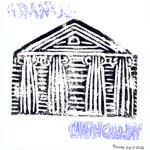 Two things are immediately important about this release. The first is
that it is limited to only 99 copies and simultaneously serves as an
excellent introduction to the breadth and depth of Petr Vastl's work as
Aranos. The second is that, aside from an episode of the Eye, this is
the only official video document of Aranos in existence and it's proof
of his abilities as both a captivating performer and consumate
musician.
Two things are immediately important about this release. The first is
that it is limited to only 99 copies and simultaneously serves as an
excellent introduction to the breadth and depth of Petr Vastl's work as
Aranos. The second is that, aside from an episode of the Eye, this is
the only official video document of Aranos in existence and it's proof
of his abilities as both a captivating performer and consumate
musician.
11235 Hits
LTM
 Section 25 were always a difficult proposition, because they were
really two bands. First, there was the late-1970s incarnation typified
by the debut album Always Now,
produced by Martin Hannett. At this phase of the band's career, the
group wore the Factory uniform through and through, pumping out bleak,
claustrophobic noise-rock owing a tremendous debt to Joy Division. This
version of Section 25 has not aged well at all, and only record
collectors and Factory fetishists actually like the music. The other
Section 25 began around 1983-4, after some personnel shifts and a
complete 180-degree change in musical strategies. Instead of
sour-faced, doomy boredom, the band embraced keyboard programming,
synthesizers and the Roland 303, producing excellent, influential early
techno that has held up surprisingly well through the years. For those
who enjoy charting the connections between the proto-electro of
Detroit/Chicago and the more stiff, angular white-boy dance and funk of
the early 1980s Manchester scene, Section 25 are ground zero. This DVD
contains both incarnations of the band, but leans heavily on the latter
phase of their chronology, which is more than fine by me. The DVD
begins with a nine-song set captured at London's ICA in the summer of
1980, and it's predictably faceless and largely uninteresting. Then
there is a set of clips from various venues dating from 1981 to 1984,
and things start to get interesting. A promotional video for "Looking
From A Hilltop" is suitably retro and quite a lot of fun, even though
the band is just miming to the recorded version of the song. The best
material comes from two shows dating from 1985, one at Chicago's Metro
Club and another at Prince's First Avenue club in Minneapolis. Section
25 is at the height of their powers here, unleashing addictively
futuristic proto-acid techno with dual live drumming, breathy vocals,
dramatic keyboard melodies and a galaxy of weird sound effects. Even at
this stage, however, Section 25 were still performing more
rock-oriented material, though it has now been retrofitted with banks
of synthesizers, Human League-style. The video and sound quality varies
wildly across the disc, but most of the best performances are watchable
and enjoyable. At over two hours, this is a generous package and a
must-have for fans of this nascent period of techno.
Section 25 were always a difficult proposition, because they were
really two bands. First, there was the late-1970s incarnation typified
by the debut album Always Now,
produced by Martin Hannett. At this phase of the band's career, the
group wore the Factory uniform through and through, pumping out bleak,
claustrophobic noise-rock owing a tremendous debt to Joy Division. This
version of Section 25 has not aged well at all, and only record
collectors and Factory fetishists actually like the music. The other
Section 25 began around 1983-4, after some personnel shifts and a
complete 180-degree change in musical strategies. Instead of
sour-faced, doomy boredom, the band embraced keyboard programming,
synthesizers and the Roland 303, producing excellent, influential early
techno that has held up surprisingly well through the years. For those
who enjoy charting the connections between the proto-electro of
Detroit/Chicago and the more stiff, angular white-boy dance and funk of
the early 1980s Manchester scene, Section 25 are ground zero. This DVD
contains both incarnations of the band, but leans heavily on the latter
phase of their chronology, which is more than fine by me. The DVD
begins with a nine-song set captured at London's ICA in the summer of
1980, and it's predictably faceless and largely uninteresting. Then
there is a set of clips from various venues dating from 1981 to 1984,
and things start to get interesting. A promotional video for "Looking
From A Hilltop" is suitably retro and quite a lot of fun, even though
the band is just miming to the recorded version of the song. The best
material comes from two shows dating from 1985, one at Chicago's Metro
Club and another at Prince's First Avenue club in Minneapolis. Section
25 is at the height of their powers here, unleashing addictively
futuristic proto-acid techno with dual live drumming, breathy vocals,
dramatic keyboard melodies and a galaxy of weird sound effects. Even at
this stage, however, Section 25 were still performing more
rock-oriented material, though it has now been retrofitted with banks
of synthesizers, Human League-style. The video and sound quality varies
wildly across the disc, but most of the best performances are watchable
and enjoyable. At over two hours, this is a generous package and a
must-have for fans of this nascent period of techno.
 Section 25 were always a difficult proposition, because they were
really two bands. First, there was the late-1970s incarnation typified
by the debut album Always Now,
produced by Martin Hannett. At this phase of the band's career, the
group wore the Factory uniform through and through, pumping out bleak,
claustrophobic noise-rock owing a tremendous debt to Joy Division. This
version of Section 25 has not aged well at all, and only record
collectors and Factory fetishists actually like the music. The other
Section 25 began around 1983-4, after some personnel shifts and a
complete 180-degree change in musical strategies. Instead of
sour-faced, doomy boredom, the band embraced keyboard programming,
synthesizers and the Roland 303, producing excellent, influential early
techno that has held up surprisingly well through the years. For those
who enjoy charting the connections between the proto-electro of
Detroit/Chicago and the more stiff, angular white-boy dance and funk of
the early 1980s Manchester scene, Section 25 are ground zero. This DVD
contains both incarnations of the band, but leans heavily on the latter
phase of their chronology, which is more than fine by me. The DVD
begins with a nine-song set captured at London's ICA in the summer of
1980, and it's predictably faceless and largely uninteresting. Then
there is a set of clips from various venues dating from 1981 to 1984,
and things start to get interesting. A promotional video for "Looking
From A Hilltop" is suitably retro and quite a lot of fun, even though
the band is just miming to the recorded version of the song. The best
material comes from two shows dating from 1985, one at Chicago's Metro
Club and another at Prince's First Avenue club in Minneapolis. Section
25 is at the height of their powers here, unleashing addictively
futuristic proto-acid techno with dual live drumming, breathy vocals,
dramatic keyboard melodies and a galaxy of weird sound effects. Even at
this stage, however, Section 25 were still performing more
rock-oriented material, though it has now been retrofitted with banks
of synthesizers, Human League-style. The video and sound quality varies
wildly across the disc, but most of the best performances are watchable
and enjoyable. At over two hours, this is a generous package and a
must-have for fans of this nascent period of techno.
Section 25 were always a difficult proposition, because they were
really two bands. First, there was the late-1970s incarnation typified
by the debut album Always Now,
produced by Martin Hannett. At this phase of the band's career, the
group wore the Factory uniform through and through, pumping out bleak,
claustrophobic noise-rock owing a tremendous debt to Joy Division. This
version of Section 25 has not aged well at all, and only record
collectors and Factory fetishists actually like the music. The other
Section 25 began around 1983-4, after some personnel shifts and a
complete 180-degree change in musical strategies. Instead of
sour-faced, doomy boredom, the band embraced keyboard programming,
synthesizers and the Roland 303, producing excellent, influential early
techno that has held up surprisingly well through the years. For those
who enjoy charting the connections between the proto-electro of
Detroit/Chicago and the more stiff, angular white-boy dance and funk of
the early 1980s Manchester scene, Section 25 are ground zero. This DVD
contains both incarnations of the band, but leans heavily on the latter
phase of their chronology, which is more than fine by me. The DVD
begins with a nine-song set captured at London's ICA in the summer of
1980, and it's predictably faceless and largely uninteresting. Then
there is a set of clips from various venues dating from 1981 to 1984,
and things start to get interesting. A promotional video for "Looking
From A Hilltop" is suitably retro and quite a lot of fun, even though
the band is just miming to the recorded version of the song. The best
material comes from two shows dating from 1985, one at Chicago's Metro
Club and another at Prince's First Avenue club in Minneapolis. Section
25 is at the height of their powers here, unleashing addictively
futuristic proto-acid techno with dual live drumming, breathy vocals,
dramatic keyboard melodies and a galaxy of weird sound effects. Even at
this stage, however, Section 25 were still performing more
rock-oriented material, though it has now been retrofitted with banks
of synthesizers, Human League-style. The video and sound quality varies
wildly across the disc, but most of the best performances are watchable
and enjoyable. At over two hours, this is a generous package and a
must-have for fans of this nascent period of techno.
9018 Hits
Another archival DVD package from LTM, unofficial torchbearers for the marginal artists on the Factory Records roster, this one collects two performances by Glawswegians The Wake.
10657 Hits
Section 25 were always a difficult proposition, because they were
really two bands. First, there was the late-1970s incarnation typified
by the debut album Always Now,
produced by Martin Hannett. At this phase of the band's career, the
group wore the Factory uniform through and through, pumping out bleak,
claustrophobic noise-rock owing a tremendous debt to Joy Division.
9277 Hits
Soleilmoon
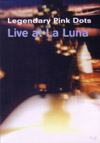 Soleilmoon's new DVD release of 1998's Live at La Luna
VHS adds absolutely nothing to the original release, sharing the same
set list and running time, and boasting absolutely zero extras. Most
disappointingly, the DVD does not even have chapter stops, making it
impossible to cue forward or back at anything more than double speed.
Would it have killed Soleilmoon to put some chapter stops between
songs?
Soleilmoon's new DVD release of 1998's Live at La Luna
VHS adds absolutely nothing to the original release, sharing the same
set list and running time, and boasting absolutely zero extras. Most
disappointingly, the DVD does not even have chapter stops, making it
impossible to cue forward or back at anything more than double speed.
Would it have killed Soleilmoon to put some chapter stops between
songs?
 Soleilmoon's new DVD release of 1998's Live at La Luna
VHS adds absolutely nothing to the original release, sharing the same
set list and running time, and boasting absolutely zero extras. Most
disappointingly, the DVD does not even have chapter stops, making it
impossible to cue forward or back at anything more than double speed.
Would it have killed Soleilmoon to put some chapter stops between
songs?
Soleilmoon's new DVD release of 1998's Live at La Luna
VHS adds absolutely nothing to the original release, sharing the same
set list and running time, and boasting absolutely zero extras. Most
disappointingly, the DVD does not even have chapter stops, making it
impossible to cue forward or back at anything more than double speed.
Would it have killed Soleilmoon to put some chapter stops between
songs?
14610 Hits
Mute
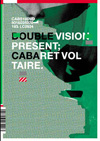 To round out their ongoing series of Cabaret Voltaire reissues, Mute has released Doublevision Present Cabaret Voltaire
on DVD. Originally issued through Factory in 1984, this DVD is
identical to the original VHS release: the same 14 videos in the exact
same sequence. It's a shame they couldn't find something extra to slap
onto the digital version, but it's still a welcome reissue for those
who have no patience for the deterioration of their VHS collection.
Doublevision was a communications company founded by Kirk, Mallinder
and Paul Smith in 1982, with the express purpose of releasing
music-based video for an affordable price, eventually transforming it
into one of the first explicitly audiovisual record labels. This is not
surprising for Cab Volt, who were always two steps ahead of their
contemporaries, it seems. For these 14 videos, Cabaret Voltaire
utilized nascent video editing technology, splicing together television
clips, performance videos and archival film footage, gluing it all
together with low-tech early video effects. The interesting thing about
watching these videos in 2004 is that the primitive video techniques,
which probably seemed piss-poor at the time of their release, now play
into the current avant-garde video art obsession with early 1980's low
budget pirate video aesthetic. 20 years on, this collection of random
video cut-ups and ugly, jagged editing techniques seems positively
vanguard. The tracks presented are from the finest period Cabaret
Voltaire: "Diskono," "Obsession," "Nag Nag Nag," and "Seconds Too
Late," among others, are represented. Televised nature and anthropology
programs are intercut with images of war, death and destruction from
new broadcasts. Clips of Leni Riefenstahl films and videos or surgeries
rub shoulders with grainy, decayed video images superimposed over each
other in a weird Burroughsian collage of overlapping transmissions,
giving rise to a mysterious "third mind" of accidental coincidences and
synchronicities. As experimental video, it all works amazingly well. As
music videos, the effect is somewhat more muted, as the edits often out
of sync with the beat structures of the music. Still, it would be hard
to imagine a more appropriate visual accompaniment to Cabaret
Voltaire's abrasive, subterranean, low-fidelity electronic music.
To round out their ongoing series of Cabaret Voltaire reissues, Mute has released Doublevision Present Cabaret Voltaire
on DVD. Originally issued through Factory in 1984, this DVD is
identical to the original VHS release: the same 14 videos in the exact
same sequence. It's a shame they couldn't find something extra to slap
onto the digital version, but it's still a welcome reissue for those
who have no patience for the deterioration of their VHS collection.
Doublevision was a communications company founded by Kirk, Mallinder
and Paul Smith in 1982, with the express purpose of releasing
music-based video for an affordable price, eventually transforming it
into one of the first explicitly audiovisual record labels. This is not
surprising for Cab Volt, who were always two steps ahead of their
contemporaries, it seems. For these 14 videos, Cabaret Voltaire
utilized nascent video editing technology, splicing together television
clips, performance videos and archival film footage, gluing it all
together with low-tech early video effects. The interesting thing about
watching these videos in 2004 is that the primitive video techniques,
which probably seemed piss-poor at the time of their release, now play
into the current avant-garde video art obsession with early 1980's low
budget pirate video aesthetic. 20 years on, this collection of random
video cut-ups and ugly, jagged editing techniques seems positively
vanguard. The tracks presented are from the finest period Cabaret
Voltaire: "Diskono," "Obsession," "Nag Nag Nag," and "Seconds Too
Late," among others, are represented. Televised nature and anthropology
programs are intercut with images of war, death and destruction from
new broadcasts. Clips of Leni Riefenstahl films and videos or surgeries
rub shoulders with grainy, decayed video images superimposed over each
other in a weird Burroughsian collage of overlapping transmissions,
giving rise to a mysterious "third mind" of accidental coincidences and
synchronicities. As experimental video, it all works amazingly well. As
music videos, the effect is somewhat more muted, as the edits often out
of sync with the beat structures of the music. Still, it would be hard
to imagine a more appropriate visual accompaniment to Cabaret
Voltaire's abrasive, subterranean, low-fidelity electronic music.
 To round out their ongoing series of Cabaret Voltaire reissues, Mute has released Doublevision Present Cabaret Voltaire
on DVD. Originally issued through Factory in 1984, this DVD is
identical to the original VHS release: the same 14 videos in the exact
same sequence. It's a shame they couldn't find something extra to slap
onto the digital version, but it's still a welcome reissue for those
who have no patience for the deterioration of their VHS collection.
Doublevision was a communications company founded by Kirk, Mallinder
and Paul Smith in 1982, with the express purpose of releasing
music-based video for an affordable price, eventually transforming it
into one of the first explicitly audiovisual record labels. This is not
surprising for Cab Volt, who were always two steps ahead of their
contemporaries, it seems. For these 14 videos, Cabaret Voltaire
utilized nascent video editing technology, splicing together television
clips, performance videos and archival film footage, gluing it all
together with low-tech early video effects. The interesting thing about
watching these videos in 2004 is that the primitive video techniques,
which probably seemed piss-poor at the time of their release, now play
into the current avant-garde video art obsession with early 1980's low
budget pirate video aesthetic. 20 years on, this collection of random
video cut-ups and ugly, jagged editing techniques seems positively
vanguard. The tracks presented are from the finest period Cabaret
Voltaire: "Diskono," "Obsession," "Nag Nag Nag," and "Seconds Too
Late," among others, are represented. Televised nature and anthropology
programs are intercut with images of war, death and destruction from
new broadcasts. Clips of Leni Riefenstahl films and videos or surgeries
rub shoulders with grainy, decayed video images superimposed over each
other in a weird Burroughsian collage of overlapping transmissions,
giving rise to a mysterious "third mind" of accidental coincidences and
synchronicities. As experimental video, it all works amazingly well. As
music videos, the effect is somewhat more muted, as the edits often out
of sync with the beat structures of the music. Still, it would be hard
to imagine a more appropriate visual accompaniment to Cabaret
Voltaire's abrasive, subterranean, low-fidelity electronic music.
To round out their ongoing series of Cabaret Voltaire reissues, Mute has released Doublevision Present Cabaret Voltaire
on DVD. Originally issued through Factory in 1984, this DVD is
identical to the original VHS release: the same 14 videos in the exact
same sequence. It's a shame they couldn't find something extra to slap
onto the digital version, but it's still a welcome reissue for those
who have no patience for the deterioration of their VHS collection.
Doublevision was a communications company founded by Kirk, Mallinder
and Paul Smith in 1982, with the express purpose of releasing
music-based video for an affordable price, eventually transforming it
into one of the first explicitly audiovisual record labels. This is not
surprising for Cab Volt, who were always two steps ahead of their
contemporaries, it seems. For these 14 videos, Cabaret Voltaire
utilized nascent video editing technology, splicing together television
clips, performance videos and archival film footage, gluing it all
together with low-tech early video effects. The interesting thing about
watching these videos in 2004 is that the primitive video techniques,
which probably seemed piss-poor at the time of their release, now play
into the current avant-garde video art obsession with early 1980's low
budget pirate video aesthetic. 20 years on, this collection of random
video cut-ups and ugly, jagged editing techniques seems positively
vanguard. The tracks presented are from the finest period Cabaret
Voltaire: "Diskono," "Obsession," "Nag Nag Nag," and "Seconds Too
Late," among others, are represented. Televised nature and anthropology
programs are intercut with images of war, death and destruction from
new broadcasts. Clips of Leni Riefenstahl films and videos or surgeries
rub shoulders with grainy, decayed video images superimposed over each
other in a weird Burroughsian collage of overlapping transmissions,
giving rise to a mysterious "third mind" of accidental coincidences and
synchronicities. As experimental video, it all works amazingly well. As
music videos, the effect is somewhat more muted, as the edits often out
of sync with the beat structures of the music. Still, it would be hard
to imagine a more appropriate visual accompaniment to Cabaret
Voltaire's abrasive, subterranean, low-fidelity electronic music.
11870 Hits







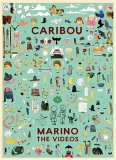
 Dan Snaith's music
(previously as Manitoba and now, Caribou) is some of the best bright
and sunny pop to roll out of speakers in recent years, and this video
collection on DVD accents that fact with mostly silly, cartoonish
visualizations of Snaith's blissful tunes.
Dan Snaith's music
(previously as Manitoba and now, Caribou) is some of the best bright
and sunny pop to roll out of speakers in recent years, and this video
collection on DVD accents that fact with mostly silly, cartoonish
visualizations of Snaith's blissful tunes.







